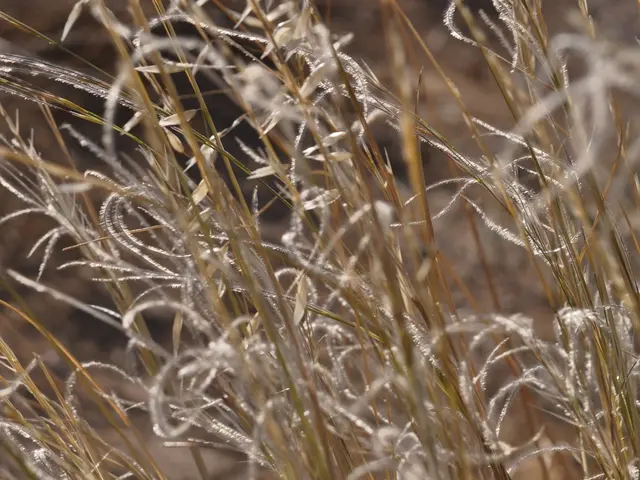Nurturing a Vibrant Home Garden: Crucial Guidelines for Cultivating a Prosperous Garden in Your Backyard
Starting a Garden: A Beginner's Comprehensive Guide
Are you looking to transform your backyard into a lush oasis, or maybe you've always dreamed of growing your own herbs, flowers, or vegetables? Whatever your gardening aspirations, this guide will equip you with the essential tips needed to cultivate a flourishing garden and reap the countless benefits it brings.
From carefully assessing your space's conditions and selecting the proper plants for your region to mastering efficient watering techniques, we'll help you navigate every stage of establishing a home garden and keeping it thriving.
Essential Tips for Starting & Maintaining Your Garden
1. Scout Your Space and Clarify Your Goals
Begin by evaluating the area available for your garden and determining your gardening objectives. Whether you're aiming to grow vegetables for your family, create a low-maintenance flower bed to boost curb appeal, or attract pollinators like bees and butterflies, understanding your priorities is crucial in guiding your decisions.
Examine the size and sunlight conditions of your possible garden spot by taking note of areas that receive ample sun, partial shade, or deep shade. Understanding your preferences helps shape each subsequent decision. If your dream is a flourishing vegetable patch, remember that most edible plants need at least six hours of direct sunlight daily. Conversely, if your space receives dappled light under trees, think about employing shade-tolerant shrubs, foliage plants, or woodland flowers. Matching your plant choices to the reality of your environment is key to a successful gardening experience.
2. Choose a Garden Style
Select a garden design that aligns with your gardening goals and aesthetic preferences, as well as functional requirements. Some may love the controlled charm of raised beds, which are easier to weed and water and can be constructed with materials like wood or stone. Others might prefer a more informal cottage garden style, filled with winding pathways and a playful blend of flowers and herbs.
If you have limited outdoor space or only a balcony, container gardening can be an excellent alternative. Pots, planters, and hanging baskets offer flexibility and can be rearranged as your plants grow. For minimalists, vertical gardening can be another option, achieved by installing trellises, shelves, or wall-mounted planters. This approach maximizes your use of vertical space and can transform even the smallest nook into a lush, vibrant zone. Regardless of the style you pick, ensure it complements your home's exterior and resonates with your personal taste.
3. Analyze and Enrich Your Soil
Soil health plays a pivotal role in a thriving garden. Test your soil's pH levels and nutrient content before buying seeds or plant starts. Many local cooperative extensions or garden supply stores can provide testing kits or services. Based on the results, you can amend your soil as needed.
Access online resources or local gardening experts to learn the appropriate ingredients for your soil type. Add organic matter like compost, well-rotted manure, or leaf mold to enrich your soil's texture, water retention, and nutrient profile. Healthy soil not only feeds your plants but also nourishes beneficial microbes and organisms that help break down organic material and maintain soil fertility.
4. Embrace Local Climate and Plant Selection
Opt for species that are adapted to your local climate and growing conditions to maximize your chances of success. Conduct research on your hardiness zone (if applicable) and identify plants that thrive in that area. Matching plant needs to the natural variations of your garden space ensures long-lasting plant health and reduces maintenance burdens.
5. Sow or Plant High-Quality Seeds and Transplants
Choose quality starting materials for a robust garden. Choose a reputable brand for seeds, or find local producers known for having high-quality seeds with reliable germination rates. If you're short on time or lack a green thumb, consider purchasing healthy transplants from nurseries. Examine the leaves, stems, and roots before selecting your plants to ensure they're free from diseases or pests.
6. Learn and Perfect Planting Techniques
Planting techniques are crucial for a successful garden. Research the appropriate depth for sowing seeds for each plant species to ensure proper germination. For transplants, dig a hole twice as wide and just as deep as the root ball. Gently remove the plant from its pot, loosen the roots if they're coiled or matted, and position it so the top of the root ball is level with the surrounding soil. Backfill the hole with a mix of your amended soil and compost, gently pat the soil around the base of the plant to remove air pockets, and water thoroughly.
7. Pair Plants Wisely
Embrace companion planting by strategically placing plants with complementary characteristics near one another. Some companion plants contribute to pest management, while others improve soil health or offer partial shade to more delicate neighbors. Integrating companion planting practices fosters biodiversity, creating a harmonious ecosystem that supports healthy plant growth.
8. Adopt a Disciplined Watering Regime
Develop a thoughtful watering routine to keep soils moist while avoiding overwatering. Use drip irrigation or soaker hoses to deliver water directly to the root zone, or water early in the morning or late afternoon to minimize evaporation. Water deeply and less frequently to encourage deep root growth and reduce water requirements.
9. Mulch and Control Weeds
Apply a layer of mulch around your plants to retain moisture, suppress weeds, and improve the appearance of your garden. Spread mulch a few inches thick, avoiding heaping it against plant stems or trunks, which can encourage rot or harbor pests. Regularly check for weeds and remove them promptly to minimize competition for nutrients and water.
10. Use Fertilizers Wisely
Apply fertilizers organically by incorporating organic matter like compost, coffee grounds, eggshells, or fish emulsion into the soil. Supplement with liquid fertilizers, such as seaweed tea or liquid kelp, to boost plant growth. Be mindful not to over-fertilize, as it can lead to nutrient burn and foliar damage.
11. Stay Vigilant for Pests and Diseases
Regularly inspect your plants for signs of pests, diseases, or nutrient deficiencies. Prevent problems by encouraging natural predators, such as ladybugs and spiders, in your garden by planting pollinator-friendly flowers. If problems arise, use gentle organic remedies like neem oil, insecticidal soap, or baking soda to combat pests and diseases.
12. Learn to Prune and Deadhead
Pruning and deadheading extend the blooming period of your plants, promote bushier growth, and improve air circulation. Keep shears sharp and clean and prune regularly according to each plant's growth cycle.
13. Practice Succession Planting
To ensure you always have fresh produce, succession planting involves sowing new seeds or transplanting new seedlings every few weeks instead of planting all at once. This technique allows for an extended harvest period and ensures you have healthy, vigorous plants.
14. Embrace Season Extenders
Use tools like cold frames, row covers, hoop tunnels, or even cloches to extend your growing season and protect delicate plants from unfavorable weather conditions. These structures provide insulation, warmth, and protection from cold and frost to enable you to start seedlings earlier in the year or extend the harvest season.
15. Maintain a Tidy Garden
Clearly defined paths make your garden easy to navigate and help discourage pests, insects, and weeds from taking up residence in neglected corners. Create and define pathways using stones, bricks, mulch, or ground cover plants.
16. Harvest Plants at the Right Time
Harvest your plants at their optimal ripeness for the best flavor, qualities, and nutritional content. Refer to online resources or guides to determine the ideal harvest time for each plant species.
17. Keep a Garden Journal
Maintaining a personal garden journal (digital or physical) helps you record your trials, experiments, and learnings, providing valuable insights that you can use to improve your gardening skills and increase yields over time. Include notes on seed starting dates, planting schedules, soil amendments, watering regimens, and any challenges or pest issues that arise.
18. Adapt and Learn
Gardening is an ongoing process, and it's essential to remain open to new discoveries, strategies, and techniques. Consult experts, online resources, and fellow gardeners to stay up-to-date on the latest gardening tips and trends.
19. Celebrate and Share Your Garden
Cherish the growth you accomplish and the fruits (or flowers) of your labor by sharing your harvest with friends, family, or neighbors or even hosting a celebration in your garden. Enjoy the time spent cultivating your space and appreciate the benefits it brings to both yourself and the environment.
20. Continue Learning and Growing
Never stop exploring and experimenting in your garden. Try growing new plants, incorporating eco-friendly practices, or implementing new techniques to keep your gardening experience rewarding, enjoyable, and sustainable.
Final Thoughts
Gardening is an empowering and life-affirming journey that allows you to connect with nature and experience the joy of witnessing growth and the natural world firsthand. By adhering to these 20 essential tips, you will establish a thriving and bountiful garden that brings delight, fresh produce, and environmental benefits to your life.
- The choice of plants should be based on the local climate and growing conditions to ensure their long-term success.
- Improving the health of your soil is crucial for a thriving garden, as healthy soil not only feeds the plants but also supports beneficial microbes and organisms.
- Matching your garden style to your preferences, functional requirements, and home's exterior will create an aesthetically pleasing space that complements your lifestyle.
- A well-thought-out watering routine can help maintain soil moisture while avoiding overwatering, fostering deep root growth and reducing water requirements.
- Companion planting, employing a combination of plants with complementary characteristics, facilitates biodiversity and encourages a harmonious ecosystem in your garden.
- Prudent use of fertilizers is essential for healthy plant growth. Choose organic methods to incorporate nutrients into the soil and avoid nutrient burn and foliar damage.
- Stay vigilant for pests, diseases, or nutrient deficiencies by inspecting your plants regularly and employing gentle organic remedies when necessary.
- Learning to prune and deadhead extends the blooming period of your plants and promotes bushier growth.
- Succession planting, sowing new seeds or transplanting new seedlings every few weeks, ensures an extended harvest period and healthy, vigorous plants.
- Embracing season extenders like cold frames, row covers, and hoop tunnels enables you to start seedlings earlier in the year or extend the harvest season.
- A tidy garden is easier to navigate and helps discourage pests, insects, and weeds from thriving in neglected corners.
- Harvest your plants at their optimal ripeness to enjoy the best flavor, qualities, and nutritional content.
- Maintaining a personal garden journal helps document your trials, experiments, and learnings, providing valuable insights to improve your gardening skills over time.
- Adapt and learn from fellow gardeners, online resources, and experts to ensure your gardening journey remains enjoyable, rewarding, and sustainable.
- Sharing the benefits of your garden with family, friends, or neighbors or hosting a celebration connects you with others and deepens your appreciation for the garden's produce and beauty.
- Continuously exploring and experimenting in your garden encourages growth, fosters eco-friendly practices, and extends your knowledge and skillset as a gardener.
- Gardening is an empowering and life-affirming journey that nurtures your connection with nature while providing a space for relaxation and enjoyment.







